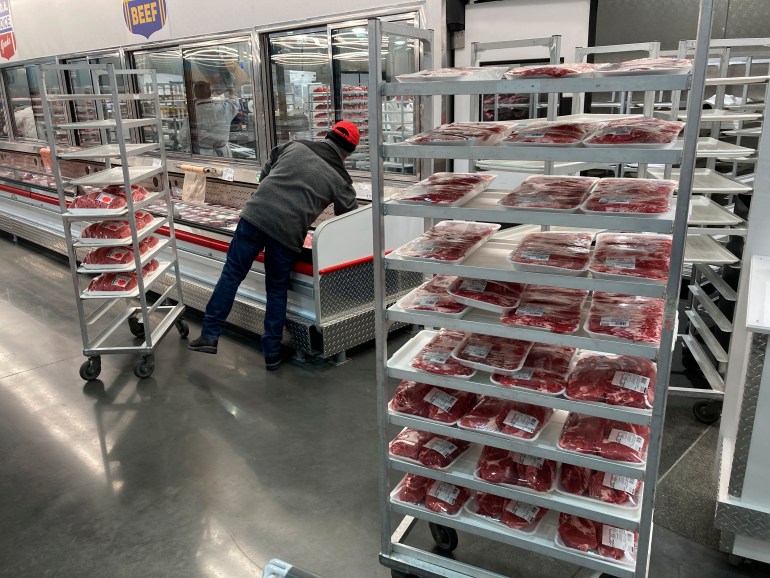US labour market remains tight, monthly producer prices rise
The reports are stoking concerns that the US Federal Reserve will continue raising interest rates to battle inflation.

The number of Americans filing new claims for unemployment benefits unexpectedly fell last week, offering more evidence of the economy’s resilience despite tighter monetary policy.
Other data on Thursday showed monthly producer prices increasing by the most in seven months in January as the cost of energy products surged. Even stripping out food and energy, prices for the so-called core goods recorded their biggest gain since last May.
Keep reading
list of 4 itemsSpain approves menstrual leave, teen abortion and trans laws
Turkey and Syria face long road to recovery after earthquakes
As cash runs out, Pakistan introduces bill to unlock IMF funds
The reports – which followed on the heels of data this week showing robust growth in retail sales in January and an acceleration in monthly consumer prices – helped to stoke financial-market fears that Federal Reserve could maintain its interest hiking campaign through summer.
“Labour market conditions remain exceptionally tight,” said Michael Pearce, lead United States economist at Oxford Economics in New York. “That is consistent with most other indicators, which suggest that the labour market is still carrying plenty of momentum, leaving the Fed on track to raise rates at its March meeting, and probably at the May meeting, too.”
Initial claims for state unemployment benefits slipped 1,000 to a seasonally adjusted 194,000 for the week ended February 11, the US Department of Labor said. Economists polled by Reuters had forecast 200,000 claims for the latest week.
Unadjusted claims dropped 9,280 to 224,727 last week, reflecting a sharp decrease in applications in California. There were also significant declines in claims in Illinois and Pennsylvania, offsetting increases in Ohio and Michigan.
Claims remain low despite high-profile layoffs in the technology sector and interest-rate-sensitive industries. Some of the laid-off workers are likely finding new work or are delaying filing for benefits because of severance packages.
Companies are generally reluctant to lay off workers after experiencing difficulties recruiting during the coronavirus pandemic. The National Federation of Independent Business reported this week that the share of small businesses reporting job openings increased in January, saying this suggested that “owners are still seeing opportunities to grow their business”.
Government data showed this month that there were 1.9 job openings for every unemployed person in December.
The claims report also showed the number of people receiving benefits after an initial week of aid, a proxy for hiring, increased 16,000 to 1.696 million during the week ending February 4.
Labour market resilience is marked by the lowest unemployment rate in more than 53 years. The Fed has raised its policy rate by 450 basis points since last March from near zero to a 4.5 percent to 4.75 percent range, with the bulk of the increases between May and December. Though two additional rate hikes of 25 basis points are expected in March and May, financial markets are betting on another increase in June.

US stocks opened lower. The dollar was steady against a basket of currencies. US Treasury prices fell.
Housing market depressed
A second report from the Labor Department on Thursday showed the producer price index for final demand rebounded 0.7 percent in January, the largest increase since June, after decreasing 0.2 percent in December. The rise was led by a 1.2 percent advance in goods prices, which followed a 1.4 percent decline in December.
A 6.2 percent jump in gasoline or petrol prices accounted for nearly a third of the increase in goods. There were also increases in prices for residential natural gas, diesel fuel, jet fuel, soft drinks and motor vehicles.
But fresh and dry vegetable prices tumbled 33.5 percent. Excluding food and energy, core goods prices shot up 0.6 percent. That was the biggest increase in core goods prices in eight months and followed a 0.2 gain in December. Services increased 0.4 percent, matching December’s gain.
In the 12 months through January, the PPI increased 6 percent after advancing 6.5 percent in December. Economists had forecast the PPI climbing 0.4 percent and rising 5.4 percent year-on-year.
News on the housing market, the biggest causality of the US central bank’s aggressive policy tightening stance, remained downbeat. Single-family housing starts, which account for the bulk of US homebuilding, dropped 4.3 percent to a seasonally adjusted annual rate of 841,000 units in January, the US Department of Commerce said in a third report.
Single-family homebuilding plunged in the Northeast and West, with the latter likely depressed by flooding in California. Homebuilding rose in the densely populated South as well as the Midwest.
Starts for housing projects with five units or more fell 5.4 percent to a rate of 457,000 units. Multi-family housing construction remains underpinned by demand for rental accommodation.
With both single and multi-family homebuilding declining, overall housing starts dropped 4.5 percent to a rate of 1.3 million units last month, the lowest level since June 2020.
Single-family building permits dropped 1.8 percent to a rate of 718,000 units, while those for housing projects with five units or more rose 0.5 percent to a rate of 563,000 units. Overall, building permits gained 0.1 percent to a rate of 1.3 million units.